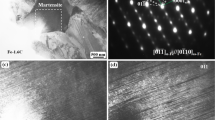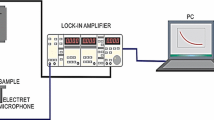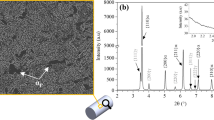Abstract
Although a coherent-incoherent transition in the ε-carbide precipitated in steels is supposedly linked to hardening and microstructural changes, the existence of this transition has not yet been confirmed. In this paper, we investigate this subject using mechanical spectroscopy. By measuring mechanical loss spectra below room temperature of quench-aged Fe-C alloys, mild steel, and pearlitic steel, we reveal a new broad peak (NBP). This peak is related to thermal activation, and its line shape obeys the equation of the Debye peak with a distribution in relaxation time. The Arrhenius plot yielded a large activation energy and gigantic pre-exponential factor. Its intensity grew by aging at temperatures where precipitation of ε-carbide has been reported. However, it starts to decay at duration far too early for ε-carbide to transform to cementite. For isothermal aging at 393 K (120 °C), the intensity sharply decreased at durations over 3 hours. This decay was accompanied by appearance of another similar peak (NBP′), which had a peak frequency two orders higher than that of NBP. These peaks had comparable intensity. We attribute NBP and NBP′ to coherent and incoherent ε-carbides, respectively. We produced a model that attributes the relaxation peaks to reorientations of extra carbon pairs in the ε-carbide. The extraordinary values of the Arrhenius parameters may be interpreted by using this model. Based on these results, we assert that mechanical spectroscopy can detect the coherent-incoherent transition in carbon steels. This method will be powerful in studying problems related to the coherency in carbon steels.











Similar content being viewed by others
References
K.H. Jack: J. Iron and Steel Inst., 1951, vol. 169, pp. 26-36.
E.M. Cohn and L.J.E. Hofer: J. Chem. Phys., 1953, vol. 21, pp. 354-359.
F.G. Caballero, M.K. Miller, and C. Garcia-Mateo : Metall. Mater. Trans. A, 2011, vol. 42A, pp. 3660-68.
W. Song, J. Von Appen, P. Choi, R. Dronskowski, D. Raabe, and W. Bleck : Acta Mater., 2013, vol. 61, pp.7582-7590.
Sigemaro Nagakura : J. Phys. Soc. Japan, 1959, vol. 14, pp. 186-195.
Hideo Abe and Takeshi Suzuki: Trans. ISIJ, 1980, vol. 20, pp.690-695.
M. Shimotomai: 17th Int. Conf. on Internal Friction and Mechanical Spectroscopy, Hafei, China. 2015. To appear in Solid State Phenomena.
B.S. Berry and A.S. Nowick: Physical Acoustics III-A, (W.P. Mason), pp. 1-42, Academic Press, New York, NY, 1966.
L.J. Dijkstra: Trans. AIME, 1949, vol. 185, pp. 252-260.
R.H. Doremus : Trans. AIME, 1960, vol. 218, pp. 596-605.
W.C. Leslie: Acta Met., 1961, vol. 9, pp. 1004-1022.
K. Abiko and H. Kimura: Trans. JIM, 1976, vol. 17, pp. 383-392.
A.S. Nowick and B.S. Berry: IBM J. Res. Develop., 1961, vol. 5, pp. 297-311.
Michio Shimotomai: Mater. Trans. JIM, 2003, vol. 44, pp. 2524-2528.
G. Boisvert, L. J. Lewis and A. Yelon: Phys. Rev. Lett., 1995, vol.75, pp. 469-472.
W.B. Jiang, Q.P. Kong, D.A. Molodov, G. Gottstein: Acta mater., 2009, vol. 57, pp. 3327-3331.
Y. Hiki: J. Non-Crystalline Solids, 2011, vol. 357, pp. 357-366.
F. Kaufman, N.J. Gerri and D.A. Pascale: J. Chem. Phys., 1956, vol. 24, pp.32-34.
Z. Karpinski, S.N. Gandhi and W.M.H. Sachtler: J. Catalysis, 1993, vol.141, pp. 337-346.
L. Nordheim and C.J. Gorter: Physica, 1935, vol. 2, pp. 383-390.
R.P. Huebener: Solid State Physics, 1972, vol. 27, pp. 63-134.
N.J. Petch: Acta Cryst., 1953, vol. 6, p.96.
C Wert: Physical Acoustics III-A, (ed. by W.P. Mason), pp. 43-75, Academic Press, New York, NY, 1966.
Tadao Iwata and Mitsuo Watanabe: Phys. Rev. B, 2010, vol. 81, 014105.
J.J. Rooney: J. Mol. Catal. A Chem., 1998, vol. 129, pp. 131-134.
G.J. Dines: J. Appl. Phys., 1952, vol. 23, pp.1194-1200.
C. Wert and C. Zener: Phys. Rev., 1949, vol.76, pp.1169-75.
Acknowledgments
The experiment was performed at Kawasaki Steel Corp. (presently, JFE Steel Corp.) as a part of the research activities of the Ferrous Super Metal Consortium of Japan under the auspices of the New Energy Development Organization of Japan (NEDO). The author is grateful to Professor H. Numakura for valuable assistance during the early stage of this investigation. He also expresses his gratitude to Dr. T. Iwata and Dr. T. Suzuki for their insightful discussions.
Author information
Authors and Affiliations
Corresponding author
Additional information
Manuscript submitted June 15, 2015.
Appendices
Appendix A. Debye equation
When a stress, σ = σ 0exp (iωt), is applied to an anelastic solid, the real part of the complex compliance is given by
and the imaginary part by
Here, ω is the circular frequency and τ is the relaxation time. The quantity δJ is defined by
which is called the relaxation of the compliance and is a measure of the magnitude of the relaxation effect. The suffixes R and U stand for relaxed and unrelaxed, respectively.
An expression for the internal friction, Q −1, is described by
where Δ is defined by δJ/J U. The Q −1 has a maximum of Δ/2 at ωτ = 1. Because the inverse of J 1 equals the modulus of the solid M, the change in relative modulus between the unrelaxed and relaxed states is related to Δ by
Appendix B. Debye Equation with a Distribution in Relaxation Time
The normalized Gaussian distribution function is given as
Here z = ln(τ/τ m), where τ m is the most probable value of τ. The quantity β measures the half-width of the distribution at the point where Ψ(z) falls to 1/e of its maximum value, Ψ(0). In this case, equations (A1) and (A2) are reformulated as
and
respectively.
Rights and permissions
About this article
Cite this article
Shimotomai, M. Coherent-Incoherent Transition of ε-Carbide in Steels Found with Mechanical Spectroscopy. Metall Mater Trans A 47, 1052–1060 (2016). https://doi.org/10.1007/s11661-015-3316-3
Published:
Issue Date:
DOI: https://doi.org/10.1007/s11661-015-3316-3




